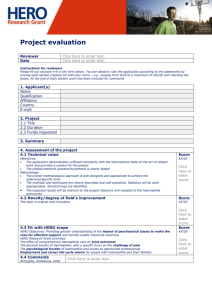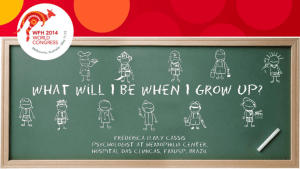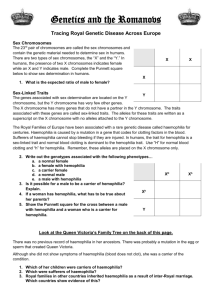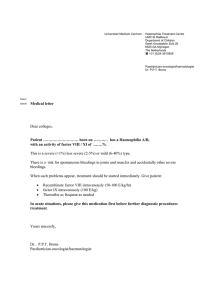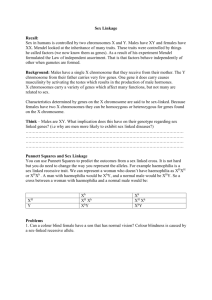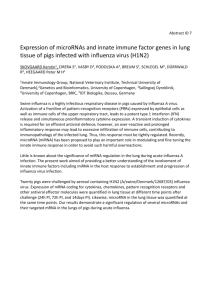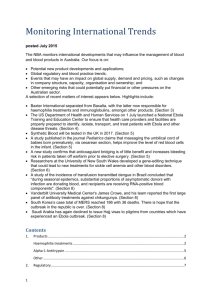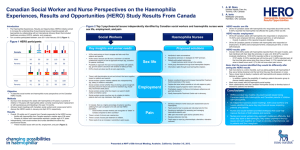October 2013 Monitoring International Trends
advertisement
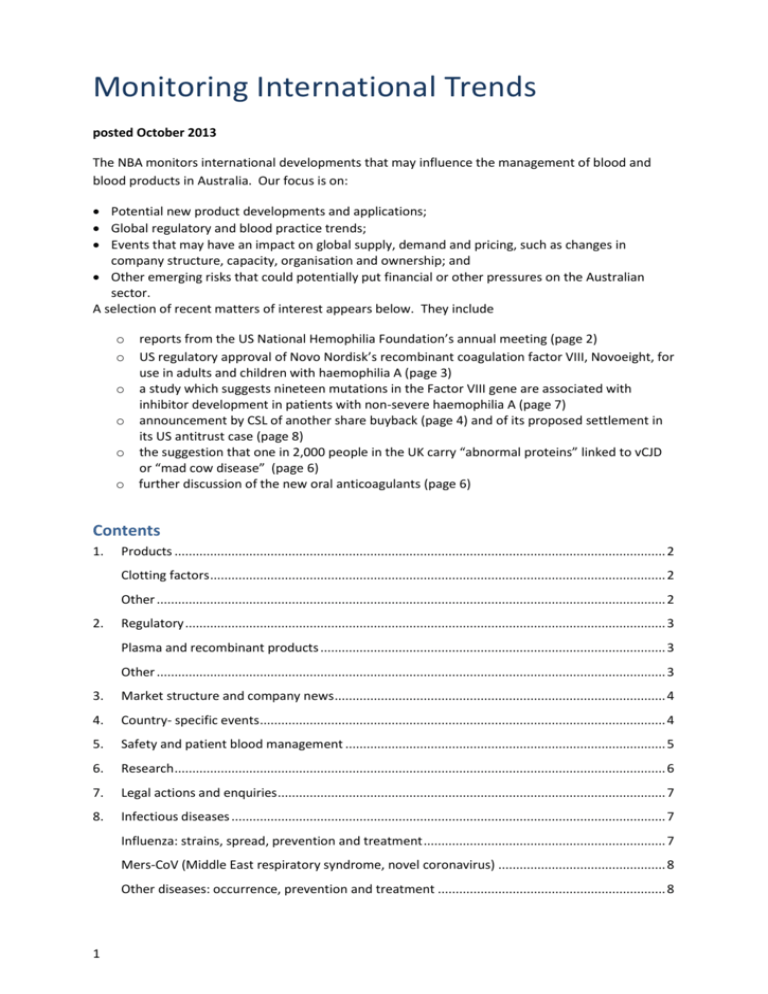
Monitoring International Trends posted October 2013 The NBA monitors international developments that may influence the management of blood and blood products in Australia. Our focus is on: Potential new product developments and applications; Global regulatory and blood practice trends; Events that may have an impact on global supply, demand and pricing, such as changes in company structure, capacity, organisation and ownership; and Other emerging risks that could potentially put financial or other pressures on the Australian sector. A selection of recent matters of interest appears below. They include o o reports from the US National Hemophilia Foundation’s annual meeting (page 2) US regulatory approval of Novo Nordisk’s recombinant coagulation factor VIII, Novoeight, for use in adults and children with haemophilia A (page 3) o a study which suggests nineteen mutations in the Factor VIII gene are associated with inhibitor development in patients with non-severe haemophilia A (page 7) o announcement by CSL of another share buyback (page 4) and of its proposed settlement in its US antitrust case (page 8) o the suggestion that one in 2,000 people in the UK carry “abnormal proteins” linked to vCJD or “mad cow disease” (page 6) o further discussion of the new oral anticoagulants (page 6) Contents 1. Products .......................................................................................................................................... 2 Clotting factors ................................................................................................................................ 2 Other ............................................................................................................................................... 2 2. Regulatory ....................................................................................................................................... 3 Plasma and recombinant products ................................................................................................. 3 Other ............................................................................................................................................... 3 3. Market structure and company news ............................................................................................. 4 4. Country- specific events .................................................................................................................. 4 5. Safety and patient blood management .......................................................................................... 5 6. Research .......................................................................................................................................... 6 7. Legal actions and enquiries ............................................................................................................. 7 8. Infectious diseases .......................................................................................................................... 7 Influenza: strains, spread, prevention and treatment .................................................................... 7 Mers-CoV (Middle East respiratory syndrome, novel coronavirus) ............................................... 8 Other diseases: occurrence, prevention and treatment ................................................................ 8 1 1. Products Here the NBA follows the progress in research and clinical trials that may within a reasonable timeframe make new products available, or may lead to new uses or changes in use for existing products. Clotting factors a) At the US National Hemophilia Foundation's (NHF) annual meeting in Anaheim, Bayer HealthCare announced that the company is introducing Kogenate FS antihemophilic factor (recombinant) with Vial Adapter, a reconstitution system which offers patients a choice additional to Bio-Set. Vial Adapter is a needleless reconstitution system that contains a sterile chamber with a built-in 15-micrometer filter and a prefilled diluent syringe. b) Octapharma presented seven clinical posters at the NHF meeting in Anaheim1. c) At the NHF meeting Grifols launched the Spirit Registry, with Spirit = Study of Plasma-derived factor VIII/VWF in Immune toleRance Induction Therapy. The registry will enrol US patients with haemophilia A and inhibitors being treated with Grifols' plasma-derived factor VIII/VWF product, Alphanate (antihemophilic factor/von Willebrand factor complex [human]). According to the registry's lead investigator, Rebecca Kruse-Jarres, of Tulane University: "There is not a lot of prospective data to help us understand how patients with inhibitors respond to treatment, especially as it relates to adherence and quality of life. The data from the SPIRIT registry will give us more information to treat our patients.” Dr. Kruse-Jarres presented a poster that outlined the registry design. Other d) The American Neurological Association annual meeting was told by Michael Toledano, of the Mayo Clinic in Rochester, Minnesota that a few weeks of intravenous immunoglobulin (IVIG) or methylprednisolone could help clinicians decide whether epilepsy not responding standard drugs was autoimmune in origin2. e) At the annual meeting of AABB (formerly the American Association of Blood Banks) in Denver, TotipotentRX and ThermoGenesis reported a study confirming TotipotentRX's acute myocardial infarction combination product utilizing ThermoGenesis' point-of-care cell processing technology for an autologous bone marrow derived stem cell therapy can be delivered safely in a 60 minute clinical procedure. f) Immunetics has updated its BacTx analyzer for use with its BacTx rapid test for bacteria in whole-blood derived and apheresis platelets. The new analyzer features automated interpretation, tracking, and documentation. g) Prolong Pharmaceuticals presented Phase I results of its lead product, Sanguinate, at the Joint Conference of the International Federation of Artificial Organs and the Japan Society of Artificial Organs in Yokohama in September. Sanguinate (PEGylated carboxyhemoglobin bovine) is an intravenous drug that combines the positive effects of a carbon monoxide releasing molecule with an oxygen transfer agent as well as being a plasma expander. The company said animal studies indicated that low dose release of carbon monoxide promoted 1 “Results of a prospective, non-interventional clinical study in 170 VWD patients with a new generation of VWF/FVIII concentrate in Germany”; “Use of double virally inactivated FVII/vWF in 30 children and young people with von Willebrand's disease - a single centre experience”; “Low inhibitor incidence in previously untreated patients with haemophilia A treated with octanate - Update from the PUP-GCP clinical trial”; “Clinical Study in Children with Severe Haemophilia A Investigating Efficacy, Immunogenicity, Pharmacokinetics, and Safety of Human-cl rhFVIII”; “Clinical Study to Investigate the Immunogenicity, Efficacy and Safety of Treatment with Human-cl rhFVIII in Previously Untreated Patients with Severe Haemophilia A”; “Bleeding frequency and consumption of FVIII concentrate during on-demand and prophylactic treatment with Human-cl rhFVIII in prospective clinical studies in adult patients with severe haemophilia A”; and “Global Development Plan for a Double Virus Inactivated Fibrinogen Concentrate for the Treatment of Congenital Fibrinogen Deficiency”. 2 Toledano M, et al "Pilot study of immunotherapy as a diagnostic test in evaluating patients with presumed autoimmune epilepsy", ANA 2013. 2 anti-inflammatory and anti-vasoconstriction effects, while oxygen was actively delivered to areas of low oxygen concentration. Prolong said the product was well tolerated, that there were no serious adverse events and that there were no discontinuations due to adverse events. h) Oxitone is developing a wrist-worn device for continuous monitoring of heart rate and oxygen saturation. It detects developing hypoxemia3. The first markets the company will chase will be for patients with chronic obstructive pulmonary disease and congestive heart failure. i) Scientists at the University of North Carolina at Chapel Hill are exploring the use of magnetomotive ultrasound (MMUS) to image platelets labelled with superparamagnetic iron oxide (SPIO) nanoparticles. They have developed a non-invasive, portable MMUS imaging system and used it to identify clots formed from SPIO-labelled platelets4. 2. Regulatory The NBA monitors overseas regulatory decisions on products, processes or procedures which are or may be of relevance to its responsibilities. Plasma and recombinant products a) The US Food and Drug Administration (FDA) has approved a Biologics License Application (BLA) from Novo Nordisk for its recombinant coagulation factor VIII, Novoeight. Novoeight was approved for use in adults and children with haemophilia A for: control and prevention of bleeding, perioperative management, and routine prophylaxis to prevent or reduce the frequency of bleeding episodes5. Novo Nordisk plans to launch the product in the US after April 2015. It will be launched with the newly introduced prefilled device, MixPro. Novoeight received positive opinion from the European Medicines Agency's Committee for Medicinal Products for Human Use (CHMP) in September 2013. Applications for regulatory approval have also been submitted in a number of other countries. b) The FDA expanded the administration options for CSL Behring’s Hizentra, immune globulin subcutaneous (human), 20% liquid, to include dosing once every two weeks (biweekly) for people diagnosed with primary immunodeficiency (PI). Hizentra received FDA approval in March 2010 as a once weekly immunoglobulin G (IgG) replacement therapy. c) The Japanese Ministry of Health, Labour and Welfare (MHLW) has approved Hizentra for the treatment of primary immunodeficiency (PID) and for the treatment of secondary immunodeficiency (SID). This is the first time any SCIg therapy has been approved for use in Japan. Other j) Cerus Corporation submitted the first of three modules for its premarket approval application (PMA) to the FDA for review of the INTERCEPT Blood System for platelets. k) Cellular Dynamics International was issued its fifth patent for 2013 by the US Patent and Trademark Office. The latest patent concerns the method by which induced pluripotent stem cells are developed into diverse types of blood vessel and blood cells. 3 Unsafe levels of oxygen in the blood. Phys. Med. Biol. 58 7277 5 Novoeight was studied in a clinical trial programme with more than 210 severe haemophilia A patients. In the completed trials Novoeight demonstrated efficacy in preventing and treating bleeds, was reported to have had no confirmed inhibitor development, and was said to have treated patients in the surgery trial effectively. 4 3 3. Market structure and company news The NBA’s business intelligence follows company profitability, business forecasts, capital raisings or returns, mergers and takeovers, arrangements for joint research and/or development, contracts for supply of manufacturing inputs, and marketing agreements. Companies considered include suppliers, potential suppliers and developers of products which may be of interest. a) Baxter International’s bioscience revenues in the third quarter of 2013 increased, driven by higher demand for Advate and Feiba. The haemophilia sub-unit had an increase of 9 per cent over the same quarter in 2012. Some analysts have downgraded Baxter’s share because of expected competition in the haemophilia market from long- acting recombinant FVIII. b) CSL will engage in another share buyback in the next twelve months, its seventh buyback program in eight years. c) Biotest has doubled its plasma collecting capacity in Hungary, and can now service the Hungarian market with products manufactured from Hungarian plasma. The company has opened two new collection centres in the US in 2013, with two more to come soon in Florida. This will give the company 15 plasmapheresis centres in the US. It has said it wishes to protect itself from supply and price fluctuations in the global plasma market. Most of its collection centres are operating seven days a week. d) Octapharma has begun construction of its 85,000 square foot facility in south Charlotte. It will house the company’s corporate operations and its plasma storage. Octapharma has 45 plasma collection centres in the US. e) US firm Catalyst Biosciences, and Isu Abxis, based in Seoul, have formed a strategic collaboration to develop Catalyst's next-generation Factor IX development candidate FIX-NG (CB 2679d). Isu Abxis will use its biologics manufacturing and development experience to advance FIX-NG through preclinical and Phase 1 studies. Isu will pay Catalyst an upfront licensing fee and milestone payments through to the end of the Phase 1 clinical trial and holds an option to commercialize FIX-NG in Korea. Catalyst retains development and commercial ownership rights outside Korea. Catalyst claimed its FIX-NG showed greater potency and longer duration of effect compared with published data for BeneFIX and competing second-generation FIX molecules, at least in hemophilia B animal bleeding models. Catalyst also has second-generation variant CB 813d (PF-05280602), a long-acting FVIIa that is in Phase 1 clinical development in collaboration with Pfizer. f) Humacyte, a regenerative medicine company, has signed an agreement with AlloSource which will .become the sole manufacturer of Humacyte's investigational bioengineered blood vessels. In 2012 Humacyte submitted an investigational new drug application to the FDA for a US clinical trial in up to 20 patients to assess safety and performance of a bioengineered vessel to provide vascular access for dialysis in end-stage renal disease patients. g) Verax Biomedical has closed its funding round, with sufficient finance to accelerate the completion of, and clinical studies for, an improved version of its bacterial contamination test for platelets for transfusion. 4. Country- specific events The NBA is interested in relevant safety issues which arise in particular countries, and also instances of good practice. We monitor health issues in countries from which Australia’s visitors and immigrants come. a) The US FDA says it will begin regulating a new wave of applications that work with smartphones to take medical readings. It says it will focus on apps that turn smartphones into devices, like a heart monitor, or attachments that plug into smartphones, like arm cuffs that measure blood pressure. 4 b) US pharmacy benefit manager Prime Therapeutics presented a study at the Academy of Managed Care Pharmacy (AMCP) conference in San Antonio that showed US treatment costs for the congenital bleeding disorders, haemophilia and von Willebrand's Disease (vWD), can vary from as little as $US 1,139 per year to more than $US 3 million per year. c) In the US, the Department of Health and Human Services has issued a proposed rule that would include hematopoietic stem cells (HSCs) acquired by apheresis under the definition of "human organ," precluding payment for them. d) Concerns are being publicly expressed in Canada that Canadians taking iron supplements may not be absorbing as much iron as they think they are. Non-heme iron supplements, made from vegetable proteins, are the most common iron supplements in Canada. They list a high measurement of elemental iron, but provide less efficient iron absorption than heme iron supplements, made from meat proteins. e) Canada’s first national (public) cord blood bank opened its doors in October. It is being run by Canadian Blood Services on behalf of the provinces and territories, except for Quebec, which runs its own program through Hema-Quebec. f) The World Federation of Hemophilia (WFH), in partnership with Canadian Blood Services, Biotest and Grifols, launched Project Recovery during the WFH Global Forum on the safety and supply of treatment products for bleeding disorders in Montreal in September. This humanitarian aid project, first conceived by the Canadian Hemophilia Society will transform previously discarded cryoprecipitate from Canadian blood donors into BIOTEST's factor VIII concentrate, called Haemoctin, to treat people with haemophilia. It will be channeled through the WFH Humanitarian Aid Program, which focuses on providing for patients in developing countries who have little or no access to therapy and are at risk of death or severe disability. The cryoprecipitate will initially be harvested by Grifols at its plant in the US, then transported by BIOTEST to Germany for manufacturing. g) "Tainted," a play which opened in Toronto in September, recalls Canada’s contaminated blood scandal when more than 1,000 Canadians became infected with HIV and another 30,000 with hepatitis C through blood products. The play presents the tragic events through the eyes of a family with three haemophiliac sons who discover they have contracted both diseases from their clotting factor treatment. h) The Thalassaemia Centre at Dubai Health Authority has begun a Transcranial Doppler (TCD) Ultrasonography screening service aimed at early detection of stroke symptoms amongst patients with sickle cell disease in the United Arab Emirates. TCD studies the flow of blood through the arteries of the brain and identifies when the blood flow is abnormal. Patients then undergo immediate exchange transfusion to reduce the risk of stroke. Silent stroke in sickle cell disease causes no immediate symptoms but is associated with brain damage. Up to 15 per cent of children with sickle cell disease suffer strokes, with silent strokes predominating in younger patients. i) Recent reviews in the UK suggest that one in 2,000 people in the UK carry “abnormal proteins” linked to vCJD (“mad cow disease”). 5. Safety and patient blood management We follow current issues in patient safety and achieving favourable patient outcomes. a) A study reported in The Journal of the American Medical Association (JAMA)6 suggested that higher numbers of blood clots detected after surgery may be signs of higher hospital quality, as it means there is more effort put into spotting at risk patients. b) Blood Cell Storage of Seattle told the annual AABB meeting in Denver, that the company is investigating the viability of using their pH SAFE® products with regular pH readings to identify platelet products compromised by bacterial contamination. 6 Online October 7 2013 5 c) The Johns Hopkins Armstrong Institute for Patient Safety and Quality was awarded a threeyear contract from the Agency for Healthcare Research & Quality to help prevent ventilatorassociated pneumonia at hospitals across the US. d) The Surviving Sepsis Campaign7 updated sepsis guidelines in 2012 to reflect knowledge gained since the previous update in 2008. A review was published online September 25 in the Annals of Emergency Medicine. e) Discussion continues on the new oral anticoagulants, relative to each other and relative to standard care. A new meta-analysis8 suggested that major bleeding complications from dabigatran etexilate (Pradaxa, Boehringer Ingelheim) in trials of atrial fibrillation and venous thromboembolism prevention tended to be less critical and more manageable than those attributed to warfarin. The worst major bleeds tended to be gastrointestinal with Pradaxa but on warfarin they were intracranial haemorrhage. A study of rivaroxaban (Xarelto, Bayer and Johnson and Johnson) found similar efficacy to standard therapy but a reduced rate of major bleeding among patients with symptomatic venous thromboembolism. A new analysis found that Pradaxa generated the largest number of adverse events reported directly to the FDA during 2012. Following Pradaxa was warfarin, the decades-old standard of care. The third new entrant in the market, Eliquis (Bristol-Myers Squibb and Pfizer) is taking longer to find wide acceptance than analysts predicted. 6. Research A wide range of scientific research has some potential to affect the use of blood and blood products. However, research projects have time horizons which vary from “useful tomorrow” to “at least ten years away”. Likelihood of success of particular projects varies, and even research which achieves its desired scientific outcomes may not lead to scaled-up production, clinical trials, regulatory approval and market development. a) Researchers from Cincinnati Children's Hospital Medical Center reported research b) c) d) e) f) 7 identifying a protein that controls the formation of different types of mature blood cells9. Researchers at Emory University have packaged stem cells to be used in heart therapy in a capsule made of alginate. The cells remain where placed and release their healing factors over time10. Researchers have found a new potential genetic target for sickle cell disease therapy. The target, described as an enhancer, controls a molecular switch in red blood cells that regulates haemoglobin production11. A study report at the 2013 Clinical Congress of the American College of Surgeons suggested that patients with bladder cancer are more than twice as likely to have complications after a radical cystectomy if their levels of blood albumin are low12. Genetically modified tobacco plants are being developed to produce albumin. Liverpool School of Tropical Medicine (LSTM) Professor Richard Pleass was awarded the Prix de l'Innovation 2013 at the Innovation Days, organised by the Universal Medica Group, at the Cité Universitaire Internationale, Paris. His project deals with the development of Hexagard, a biomimetic to replace intravenous immunoglobulin (IVIG) therapy for treating autoimmune diseases. He says Hexagard is approximately 50 fold more effective than IVIG. He said: "Winning the Innovation Prize is a huge vote of confidence in Hexaguard™ as a treatment for auto-immune disease, such as idiopathic thrombocytopenic purpura (ITP). We launched in 2002, and a joint task of the Society of Critical Care Medicine and the European Society of Intensive Care Medicine 8 published online September 30, 2013 in Circulation 9 Journal of Experimental Medicine, online October 7. 10 Rebecca Levit et al., in the Journal of the American Heart Association, October 10 2013. 11 "An Erythroid Enhancer of BCL11A Subject to Genetic Variation Determines Fetal Hemoglobin Level" Science, 2013. 12 The study was led by Dr David Johnson from the University of North Carolina School of Medicine, Chapel Hill. 6 will continue to develop this molecule at LSTM and are looking forward to finding partners to take this exciting new drug into commercial production." Jean Derégnaucourt of the Innovation Days jury, said that that Hexagard, had the nine S's: small, stable, safe, synthesizable; scalable, suitable, superior, serviceable and saleable. g) A retrospective cohort study suggests nineteen mutations in the Factor VIII gene were associated with inhibitor development in patients with nonsevere hemophilia A, demonstrating the value of Factor VIII genotyping in this patient population. “The inhibitor incidence in nonsevere hemophilia A patients with certain F8 mutations approaches the inhibitor incidence in severe patients,” said Corien de Groot-Eckhardt, of Emma Children’s Hospital in Amsterdam. “These findings are highly relevant for clinical practice as they facilitate identification of high-risk patients based on their F8 genotype.” h) In the US, the Defense Advanced Research Projects Agency (DARPA) has extended a $US 6.8 million contract with San Diego-based Aethlon Medical. DARPA is exercising an option to continue with year three of the contract, which was awarded to Aethlon in 2011 to develop blood filtration devices for infectious disease and cancer. The company is developing a portable device to remove “dirty” blood from the body, separate out the harmful agents, and return “clean” blood to the body. The aim is to decrease the morbidity and mortality of sepsis. 7. Legal actions and enquiries The NBA is interested in the implications for Australia of any proceedings against companies, governments and professional practitioners in relation to blood and blood products; or of relevant public enquiries. a) Bristol-Myers Squibb and Sanofi-Aventis in September faced over 40 complaints in New York state court as part of a coordinated litigation claiming that blood-thinning drug Plavix caused its users to suffer haemorrhages, including gastro-intestinal and cerebral haemorrhages. b) CSL’s annual general meeting was told that a legal settlement, yet to be approved by the US federal court, would reduce net profit by $US 39 million. CSL had already announced it would settle an antitrust lawsuit for $US 64 million, the lawsuit filed by hospitals in the US and Puerto Rico. 8. Infectious diseases The NBA takes an interest in infectious diseases because: the presence of disease in individual donors (e.g. influenza), or potential disease resulting from travel (e.g. malaria) means a donor must be deferred; temporary disease burden within a community (e.g. dengue in North Queensland) may limit blood collection in the community for a time; and some people may not be permitted to donate at all (e.g. people who lived in the UK for a period critical in the history of vCJD). Blood donations are tested for a number of diseases (e.g. HIV and Hepatitis B), but there are also emerging infectious diseases for which it may become necessary to test in the future (e.g. Chagas disease, and the tick-borne babesiosis and Lyme disease). Influenza: strains, spread, prevention and treatment a) By 26 October, the World Health Organization, WHO, had been notified of 137 laboratoryconfirmed cases of H7N9 flu, originating in China. There had been 45 deaths. b) In September WHO had selected an A/Anhui/1/2013-like virus for the development of H7N9 vaccines for pandemic preparedness. It noted that A/Shanghai/2/2013 is an A/Anhui/1/2013-like virus. The candidate vaccine virus and other H7N9 strains are being shared under the WHO's Pandemic Influenza Preparedness Framework. c) H7N9 pandemic bird flu vaccines are being tested in the US. Taiwan says it will roll out its H7N9 vaccine in late 2014. 7 d) Replikins announced that it has successfully developed a vaccine against the influenza strain H5N1 that is now ready for testing. e) WHO recommended that trivalent vaccines for use in the 2014 influenza season (southern hemisphere winter) contain the following: - an A/California/7/2009 (H1N1)pdm09-like virus (a); - an A/Texas/50/2012 (H3N2)-like virus (b); - a B/Massachusetts/2/2012-like virus. WHO recommended that quadrivalent vaccines containing 2 influenza B viruses contain the 3 viruses above and a B/Brisbane/60/2008-like virus. WHO noted (a) A/Christchurch/16/2010 is an A/California/7/2009-like virus; (b) A/Texas/50/2012 is an A(H3N2) virus that following adaptation to growth in eggs has maintained antigenic properties similar to the majority of recently circulating cell-propagated A(H3N2) viruses > including A/Victoria/361/2011. f) Avian flu (but not H5N1) has been found on two NSW egg farms. g) Discovery of a novel influenza virus, H18N11, in several species of Peruvian bats suggests New World bats can be an important reservoir.13 Mers-CoV (Middle East respiratory syndrome, novel coronavirus) h) WHO’s International Health Regulations Emergency Committee unanimously decided on 2 October not to declare a Public Health Emergency of International Concern related to the Middle East respiratory syndrome coronavirus. i) By 25 October there had been 144 confirmed cases of MERS. Other diseases: occurrence, prevention and treatment j) Scientists from Case Western Reserve University have suggested a promising discovery for the prevention and treatment of prion diseases. They claim recombinant human prion protein stops the propagation of prions14. k) Chimerix announced the publication of results from its Phase II Study of CMX001-201 evaluating brincidofovir (CMX001) for the prevention of cytomegalovirus (CMV) infection in hematopoietic cell transplant (HCT) recipients15. l) In September, Queenslanders were urged to check their measles vaccination status after the fourteenth diagnosis for the year. West Australian travellers were warned to watch for symptoms if they had been in Bali, as returning travellers had contracted the disease. m) Trials of a malaria vaccine developed by GlaxoSmithKline almost halved the cases of malaria in children aged between five and seven months and reduced by one quarter the number of cases in babies aged six to twelve weeks. 13 Tong S, Zhu X, Li Y, Shi M,"New World Bats Harbor Diverse Influenza A Viruses", by in PLoS Pathog 9(10): e1003657. doi:10.1371/journal.ppat.1003657 14 Published online in Scientific Reports. Senior author Wen-Quan Zou, associate professor of pathology and neurology at the University’s School of Medicine. 15 "CMX001 to Prevent Cytomegalovirus Disease in Hematopoietic-Cell Transplantation," appears in the September 26(th) issue of the New England Journal of Medicine (N Engl J Med 369:1227-36). 8
